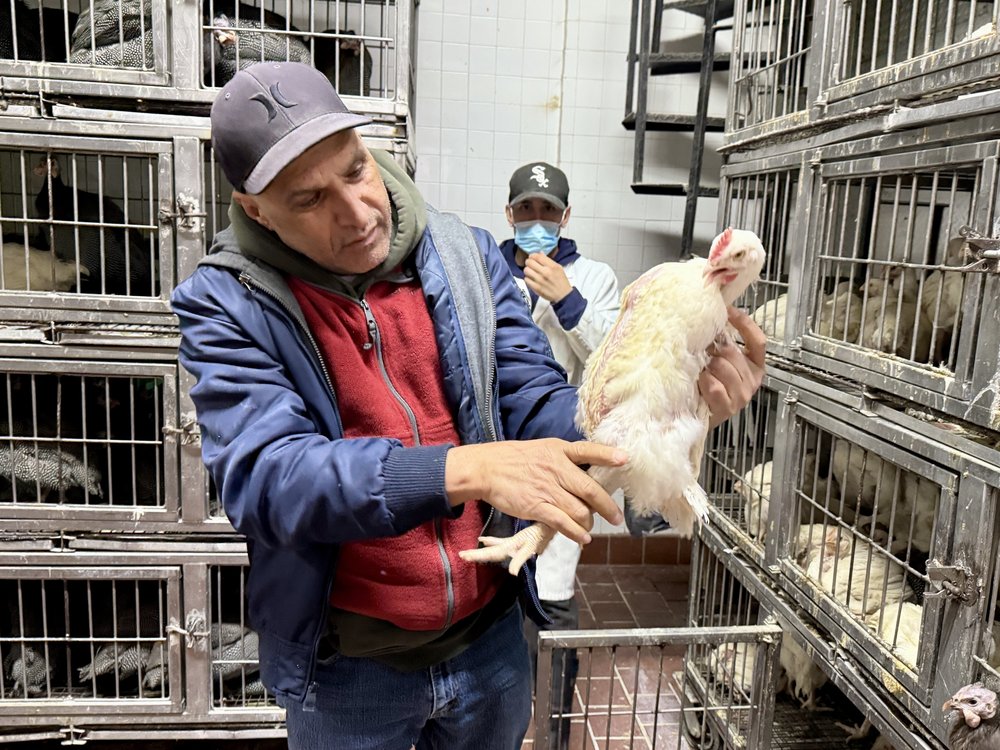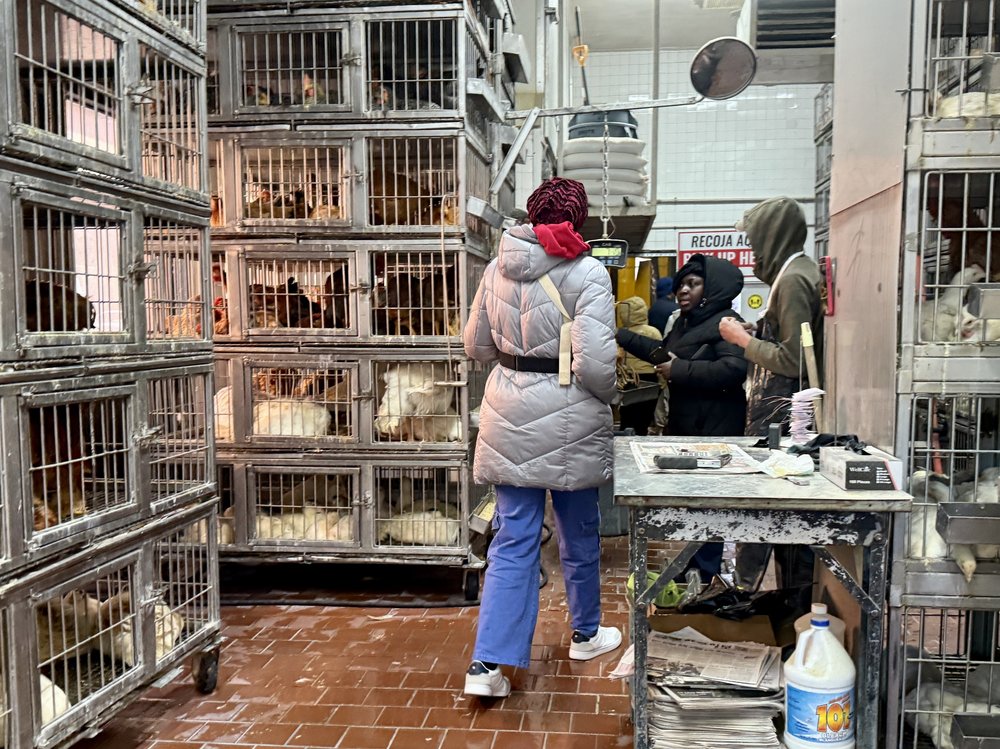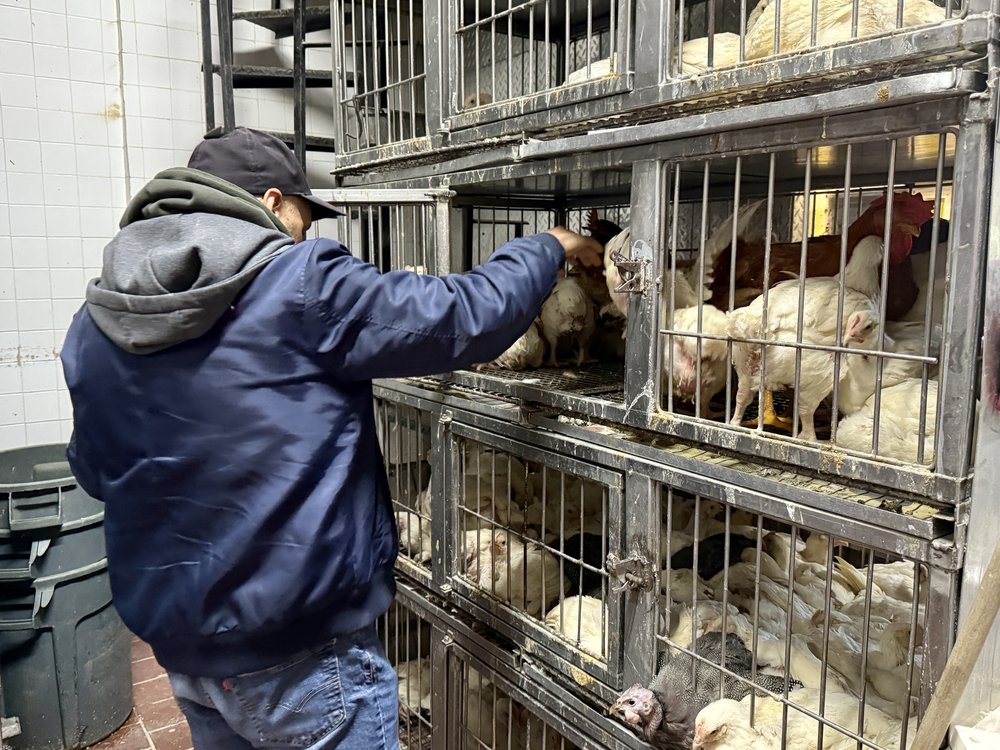Why does New York City have around 70 live animal markets?
March 14, 2025, 10 a.m.
NYC’s wet markets sell thousands of chickens a month, but public health experts say they pose health risks.

New York City’s wet markets – stores that house and slaughter mostly live poultry – landed in the spotlight last month after bird flu was detected at nine downstate markets, prompting Gov. Kathy Hochul to temporarily shut down markets in the New York City metro area to prevent its spread.
Since the wet markets reopened in mid-February, inspectors have found the virus in birds at seven more of the city’s roughly 70 wet markets, which remain open and serve thousands of customers weekly.
A spokesperson for the state's Department of Agriculture, which performs quarterly unannounced inspections and bird flu testing at the markets, said it may order another shutdown if clear evidence persists that bird flu is spreading in the live poultry business.
Public health experts have highlighted the city’s wet markets as environments where viruses spreading between animal species can mutate and potentially become more transmittable to humans. While there have been 70 confirmed cases of bird flu spreading to humans nationwide since 2024 – including one fatality – none have been in New York state.

Meanwhile, New York City’s wet markets continue to sell thousands of birds a month, according to state data from 2023. One estimate from 2021 put the total at roughly 1 million live birds per month. Several customers interviewed for this story said they prefer the fresher, higher-quality meat from these markets, while others count on them for halal or other specific slaughter practices.
‘The meat tastes completely different’
La Granja Live Poultry, an unassuming corner storefront in West Harlem next to an artisanal coffee roaster selling $7 espresso tonics, is quiet from the outside. But inside, cages packed with squawking chickens as well as turkeys, quails and even rabbits line the walls from floor to ceiling.
Spend an hour there and you’ll hear a half-dozen languages, including Spanish, Haitian Creole, Arabic and Bengali. Owner Jose Fernandez, who has run the store since 1999, said he gets just about every type of customer you can imagine – except one.
“I don’t have too many customers that are white people, because they don’t cook too much,” Fernandez said, laughing. “They eat in the restaurant, so their life is very different. In my house we cook every day.”

Fernandez, originally from the Dominican Republic, said his customers are mostly like him: people with roots in other countries who are used to eating chickens raised outside on a diet of corn, grass, and insects.
“The meat tastes completely different from the meat you can buy at the supermarket or butcher,” Fernandez said in Spanish. “People who come here know the difference, the taste of real chicken.”
And many of his customers follow halal or other dietary laws, Fernandez said, which require specific slaughter methods he can accommodate.
Fernandez said he sells about 4,000 chickens a week, he said, along with small numbers of game birds and rabbits. The corkboard walls of his tiny office at the front of the store are covered with supplier invoices and the business cards of various officials at the federal and state Departments of Agriculture. He said his store underwent regular unannounced inspections.
On the shop floor, staff regularly sweep and hose down the tile. Behind a counter in the back, birds are plucked and processed in about eight minutes, returning whole or in pieces, encased in plastic and resembling the chicken sold at the Whole Foods a few blocks east (though considerably cheaper at $3.20 per pound versus $4.49 per pound advertised at the Whole Foods).

Tania Cardenas, originally from Ecuador, recently picked up two chickens at La Granja – “The Farm,” in Spanish.
“They’re better this way,” Cardenas said in Spanish. “For my health, I prefer fresh. When they’re slaughtered here and I can see the blood drain, I know I’m eating something fresh that won’t make me sick.”
‘There’s blood, feces, body parts, overcrowded birds’
Public health experts say the risks of shopping at wet markets outweigh any benefits. While properly cooked eggs and meat are safe to eat, a wide body of literature has identified such markets as high-risk sites for transmitting disease from animals to humans – most notably as a potential origin of COVID-19.
Live poultry markets create ideal conditions for this “zoonotic” transmission, according to Ann Linder, associate director of policy and research at Harvard Law School’s Animal Law and Policy Program and lead author of a 2024 study that examined disease transmission at wet markets in 15 countries, including the United States.
Birds from multiple farms are mixed together, increasing the risk that one may carry a pathogen, she said. Because they are packed into tight quarters, often in stressful conditions that weaken their immune systems, they become more vulnerable to infection.
While the ongoing bird flu outbreak, which started in 2022 and picked up sharply again this year, is largely concentrated in major “factory farm” producers in the Midwest, that doesn’t guarantee that the city’s wet markets are safe, Linder said.

“It’s a constant influx of new birds and new potential pathogens,” Linder said, referring to the fact that birds are sourced from multiple farms. She said wet markets are especially risky because customers examine the birds up close and the animals are slaughtered on site, potentially creating more avenues for transmission. Additionally, she said that because wet markets often operate in dense, residential neighborhoods in New York City, an outbreak that starts here could be especially hard to contain.
Indeed, with more bird flu detections at the city’s wet markets since their reopening than before the initial shutdown, activists, city councilmembers, and even Republican mayoral candidate Curtis Sliwa are questioning why they remain open. Children and the elderly are especially vulnerable to bird flu, according to the CDC.
In the United States there have been 70 cases of bird flu detected in humans since the current outbreak began spiking again in 2024, with one fatality reported in Louisiana in January. For now, the disease does not appear to spread easily from animals to humans, but public health experts expressed concern that it will mutate to become more easily transmissible.
“I literally don’t think there’s anything any market could do to actually be shut down,” said Edita Birnkrant, executive director of the animal rights organization New Yorkers for Clean, Livable and Safe Streets.
Birnkrant has been documenting conditions at some of the city’s wet markets for years.
“There’s blood, feces, body parts, overcrowded birds,” Birnkrant said of a store in Queens that she visited on Tuesday. “Many we found with open wounds because the birds are cannibalizing each other.”
Chantal Gomez, a spokesperson for the city’s Department of Health, said that while her agency provides guidance to workers on proper protective equipment and handling dead birds, they don’t have a specific program to educate consumers about the risks these markets pose.
Jarra Jagne, a professor of public and ecosystem health at Cornell’s College of Veterinary Medicine who has studied Northeast U.S. bird markets extensively, said that strict regulations introduced in 2003 made the markets much safer, such as one mandating that different species be caged separately.
The recent cases of bird flu in markets are to be expected given the ongoing national outbreak, she said, but do not highlight an inherent problem with the markets themselves.
“I’ve been to many, many of these markets, and the change from before is just enormous,” Jarra said, referring to the period before the 2003 regulations.
Back at La Granja, Fernandez said the state’s monitoring and detection program is sufficient for him and his customers to feel safe.
Demand surged after the weeklong shutdown before business normalized and then slowed a little, he said.
He’s not sure why. It could be the economy, he said. But most likely it’s the usual seasonal pattern – his customers often give up meat for Lent and Ramadan.
Correction: A previous version of this story misstated the name of the spokesperson for the city’s Department of Health.
An NYC comedian joked about the upside of gentrification. Then came the firestorm. Astoria’s first-ever fig tree exchange is this Sunday